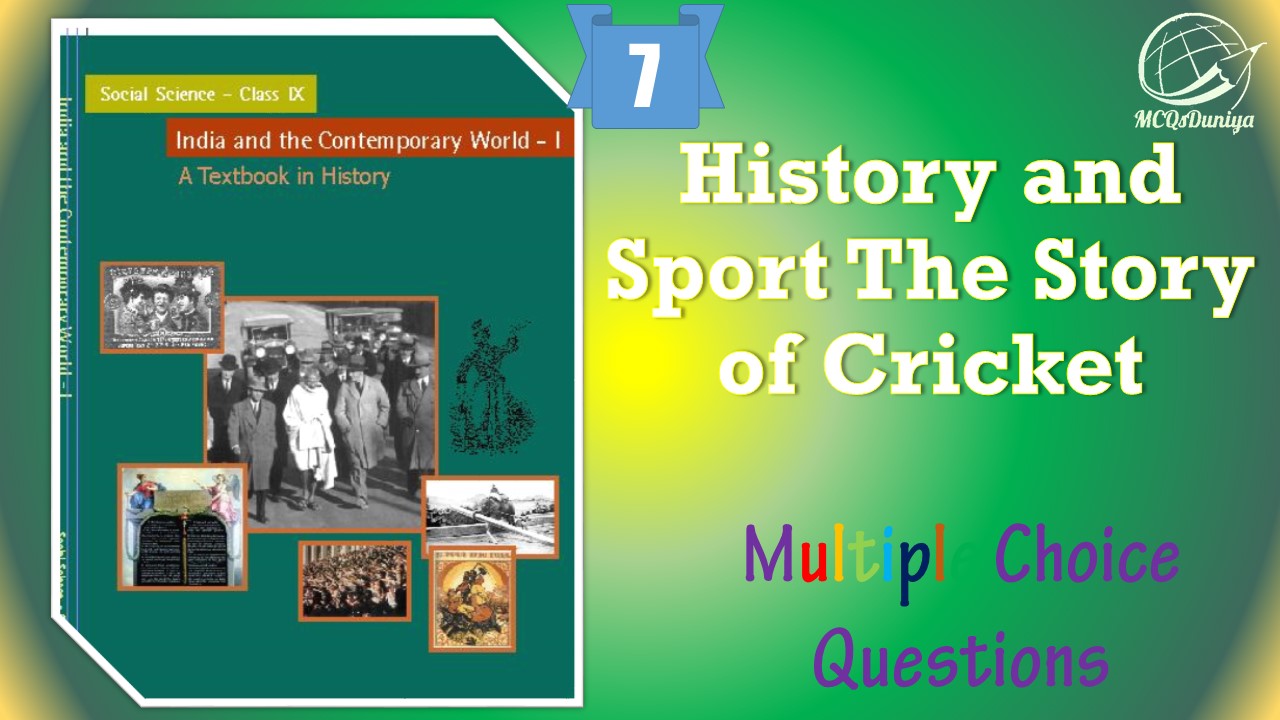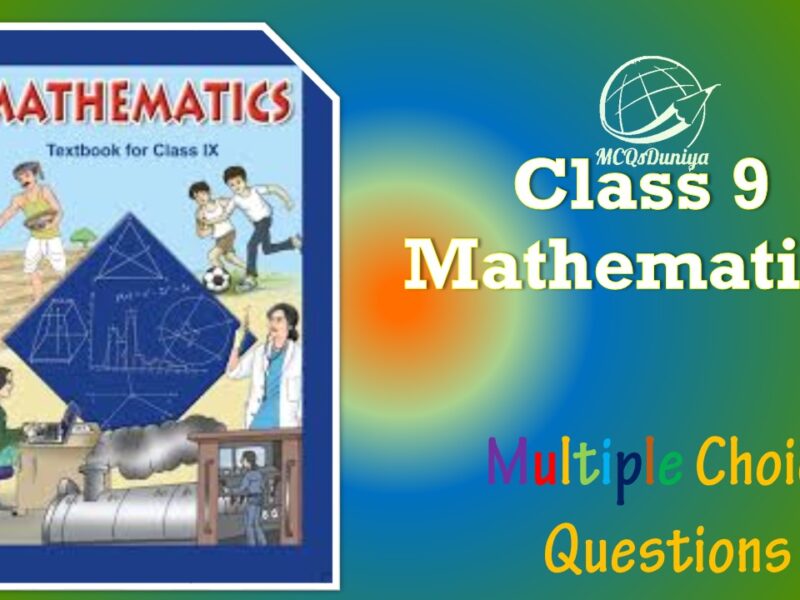Class 9 Social Science History MCQ History and Sport The Story of Cricket with Answers is Prepared Based on Latest Exam Pattern. Students can solve NCERT Class 9 Social Science History MCQ History and Sport The Story of Cricket with Answers to know their preparation level.
Students who are searching for NCERT Class 9 Social Science History MCQ History and Sport The Story of Cricket with Answers are compiled here to get good practice on all fundamentals. Know your preparation level on MCQ Questions for Class 9 Social Science History MCQ History and Sport The Story of Cricket with Answers. You can also verify your answers from the provided Class 9 Social Science History MCQ History and Sport The Story of Cricket with Answers. So, ace up your preparation with MCQ of Class 9 Social Science History MCQ & NCERT Textbook solutions Examinations.
NCERT Class 9 Social Science History MCQ History and Sport The Story of Cricket with Answers
Question : In which year cricket was changed forever?
(a) In 1977
(b) In 1977
(c) In 1987
(d) In 1783
Answer :(a) In 1977Show Answer :
Question : The ICC headquarters shifted from London to
(a) Sydney
(b) India
(c) Dubai
(d) Singapore
Answer :(c) DubaiShow Answer :
Question : When was the Marylebone Cricket Club founded?
(a) 1760
(b) 1787
(c) 1788
(d) 1895
Answer :(b) 1787Show Answer :
Question : When was six seem ball created?
(a) In 1980
(b) In 1880
(c) In 1780
(d) In 1680
Answer :(c) In 1780Show Answer :
Question : Who was Palwankar Baloo?
(a) A Congress leader
(b) A soldier
(c) A Dalit cricketer
(d) A Brahmin priest
Answer :(c) A Dalit cricketerShow Answer :
Question : The reason that cricket has originated from the villages is/are
(a) Cricket matches had no time limit
(b) Vagueness of the size of the cricket ground
(c) Cricket’s most important tools are all made of pre-industrial materials
(d) All the above
Answer :(d) All the aboveShow Answer :
Question : What is the full from of ICC?
(a) International Cricket Council
(b) International Cricket Co-operative Nation
(c) International Cricket Confeder-ation
(d) Imperial Cricket Council
Answer :(a) International Cricket CouncilShow Answer :
Question : Name the hockey player from India who won many Olympic gold medals.
(a) Balbir Singh
(b) Dhyan Chand
(c) Dhanraj Pillai
(d) Gagan Ajit Singh
Answer :(b) Dhyan ChandShow Answer :
Question : What was the term ‘tournament’ called initially?
(a) Triangular
(b) Quadrangular
(c) Angular
(d) Pentangular
Answer :(b) QuadrangularShow Answer :
Question : Which was the first Indian Community to play cricket?
(a) Parsies
(b) Zoroiastrian
(c) Trader and businessmen
(d) Social weaker section of the society
Answer :(b) ZoroiastrianShow Answer :
Question : In which country was cricket played for the first time?
(a) England
(b) Rome
(c) Spain
(d) India
Answer :(a) EnglandShow Answer :
Question : How did the cricket boards become rich?
(a) By organising large number of matches
(b) Through patronage from rich industrialists
(c) By selling television rights to television companies
(d) None of the above
Answer :(c) By selling television rights to television companiesShow Answer :
Question : First cricket club formed in 1760’s in
(a) Melbourne
(b) Lords
(c) Manchester
(d) Hambledon
Answer :(d) HambledonShow Answer :
Question : Which among the following is not associated with amateurs?
(a) The rich who played it for pleasure
(b) Who considered sport a kind of pleasure
(c) Pleasure of playing and not for money
(d) Player who played it for a living
Answer :(d) Player who played it for a livingShow Answer :
Question : The first hockey club in India was started in
(a) Bombay
(b) Madras
(c) Bangalore
(d) Calcutta
Answer :(d) CalcuttaShow Answer :
Question : Amatures stand for:
(a) Reserve players
(b) Rich people who could afford to play cricket
(c) Rich people who have no time to play cricket
(d) Poor people who could play cricket
Answer :(b) Rich people who could afford to play cricketShow Answer :
Question : The world series cricket was started by:
(a) C.K. Nayudu
(b) Palwankar Baloo
(c) Kerry Packer
(d) Dennis Lillee
Answer :(c) Kerry PackerShow Answer :
Question :When were first written Law of Cricket drawn?
(a) In 1754
(b) 1764
(c) In 1744
(d) 1756
Answer : (c) In 1744Show Answer :
The first written Law of Cricket was drawn in 1744.
Question :In which year cricket was changed forever?
(a) In 1977
(b) In 1977
(c) In 1987
(d) In 1783
Answer : (a) In 1977Show Answer :
In 1977 cricket was changed forever.
Question :When was six seem ball created?
(a) In 1980
(b) In 1880
(c) In 1780
(d) In 1680
Answer : (c) In 1780Show Answer :
In 1780 six seem ball was created.
Question :Who led the professional team in 1930’s?
(a) Len Hutten
(b) W.C. Grace
(c) David Hutton
(d) David Gover
Answer : (a) Len HuttenShow Answer :
Len Hutten led the professional team in 1930’s.
Question :The word cockade refers to:
(a) type of fur
(b) type of cricket ball
(c) type of the bat used by batsman
(d) cap usually worn on one side
Answer : (d) cap usually worn on one sideShow Answer :
The word cockade refers to the cap usually worm on one side.
Question :What is the full from of ICC?
(a) International Cricket Council
(b) International Cricket Co-operative Nation
(c) International Cricket Confeder-ation
(d) Imperial Cricket Council
Answer : (a) International Cricket CouncilShow Answer :
The full form of ICC is International Cricket Council.
Question :Which was the first Indian Community to play cricket?
(a) Parsies
(b) Zoroiastrian
(c) Trader and businessmen
(d) Social weaker section of the society
Answer : (b) ZoroiastrianShow Answer :
Zoroastrian were the first Indian Community to play cricket.
Question :Where was cricket invented?
(a) In England
(b) In Australia
(c) In West Indies
(d) In South Africa
Answer : (a) In EnglandShow Answer :
Cricket was first invented in England.
Question :First cricket club formed in 1760’s in
(a) Melbourne
(b) Lords
(c) Manchester
(d) Hambledon
Answer : (d) HambledonShow Answer :
In Hambledon was the first cricket club formed in 1760’s.
Question :When was cricket invented?
(a) In early 19th century
(b) In early 17th century
(c) In early 16th century
(d) In mid of the 17th century
Answer : (c) In early 16th centuryShow Answer :
Cricket was invented in the early 16th century.
Question :Amatures stand for:
(a) Reserve players
(b) Rich people who could afford to play cricket
(c) Rich people who have no time to play cricket
(d) Poor people who could play cricket
Answer : (b) Rich people who could afford to play cricketShow Answer :
Rich people who could afford to play cricket were called amateurs.
Question :Who are professional in cricket?
(a) Those who play cricket for enjoyment.
(b) Those who play cricket for time pass.
(c) Those who play cricket for living.
(d) Those who play cricket as a hobby.
Answer : (c) Those who play cricket for living.Show Answer :
Professional in cricket are those people who play cricket for living.
Question :Where was India’s first cricket club established?
(a) In Mumbai
(b) In Calcutta (Kolkatta)
(c) In Madras (Chennai)
(d) In Delhi at Feroze Shah Kotla
Answer : (b) In Calcutta (Kolkatta)Show Answer :
In Calcutta (Kolkatta), India’s first cricket club was established.
Question :What is the specified length of the pitch?
(a) 22 yards
(b) 22 feet
(c) 22 metres
(d) 80 feet
Answer : (a) 22 yardsShow Answer :
The specified length of the pitch is 22 yards.
Write true (T) or false (F)
Question : The word ‘bat’ is an old English world that means stick or club.
Answer : TrueShow Answer :
Question : One of the peculiarities of Test Cricket is that a match can go for 6 days and still end in a draw.
Answer : FalseShow Answer :
Question : The length of the pitch is specified 22 metres but the size and shape of the ground is not.
Answer : FalseShow Answer :
Question : Cricket was the earliest modern team sports to be codified.
Answer : TrueShow Answer :
Question : The first written ‘Laws of Cricket’ ever drawn up in 1746.
Answer : FalseShow Answer :
Question : The stumps must he 22 inches high and the bail across them six inches.
Answer : TrueShow Answer :
Question : The cricket ball must be between 6 and 7 ounces.
Answer : FalseShow Answer :
Question : The two sets of stumps must be 22 metres apart.
Answer : FalseShow Answer :
Question : The world’s first cricket club was formed in Hambledon in the 1760s.
Answer : TrueShow Answer :
Question : The Marylebone Cricket Club was founded in 1788.
Answer : FalseShow Answer :
Question : During the 1760s and 1770s, it became common to pitch the ball through the air, rather than roll it along the ground.
Answer : TrueShow Answer :
Question : The weight of the ball was limited between 6
Answer : FalseShow Answer :
Question : Cricket’s connection with an urban past can be seen in the length of a Test Match.
Answer : FalseShow Answer :
Question : Cricket’s vagueness about the size of a cricket ground is a result of its village origins.
Answer : TrueShow Answer :
Question : The invention of vulcanised rubber led to the introduction of pads in 1848.
Answer : TrueShow Answer :
Question : The organisation of cricket in England reflected the nation of English society.
Answer : TrueShow Answer :
Question : The gram of cricket was not seasonal and it offered employment the year around.
Answer : FalseShow Answer :
Question : The society superiority of amateurs was built into the curtain of cricket
Answer : TrueShow Answer :
Question : Amateurs were even called holymen while professionals were called players.
Answer : FalseShow Answer :
Question : Thomas Hughes studied at Rugby School during the headmastership of Thomas Arnold.
Answer : TrueShow Answer :
CBSE Class 9 Social Science History MCQ Peasants and Farmers with Answers
NCERT Solutions & Download NCERT Textbooks



